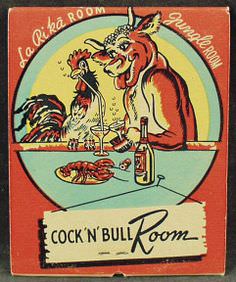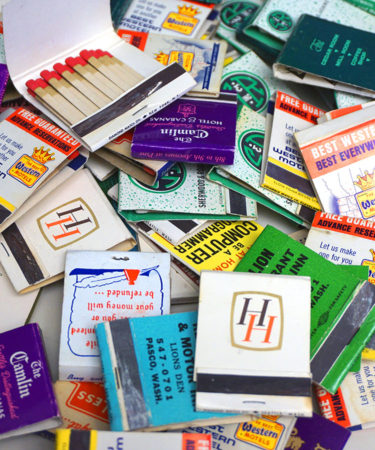We live in a digital age (please don’t click away, I know, every single article that starts that way is terrible). But it is kinda true. Most every convenience and social experience has been scrunched up, shoved into wires, and digitized. But try as we might, there’s one thing we can’t store in the Cloud, or find an app for, or “Like” on Facebook. And that’s fire.
Ten years from now we might all be downloading Taylor Swift’s first hot divorce single into our brains, but we’ll still need some tangible source of fire if we want, well, fire to burn stuff. And while lighters—bics and the Zippos your older brother used to show off—basically dominate the game now, matches are making a mini and (god save us) “retro” comeback. Especially at bars and restaurants.

That was the first thing that prompted us to look into the history of the matchbook (and yes, yawn, right?). Except no, it’s full of controversy, ineptitude, preventative rat safety measures, and various parties interested in owning the rights to a foldy cardboard book that contains 20 ways to make fire. OK, 15 if we’re counting all the failed attempts.
Really, the history of the matchbook is kind of weird. And not just because, for a while there in the 1940s, matchbooks seemed to be the chief mode of communication between Private Detectives and people with information. Usually phone numbers, sometimes weird passwords, every once in a while a blotch of red lipstick. But the weirdest thing about the matchbook is that two dudes actually patented it. And one was a patent lawyer.
Google “matchbook history” and The New York Times will cite Joshua Pusey, Philadelphia patent lawyer and dandy (as in a dude who wore suits), not only as the inventor of the bendy cardboard matchbook, but the toboggan. Which yes, so far as we can tell, makes him an incredible man: “I have two priorities: fire and sledding.” According to the Times, Pusey invented the matchbook out of vanity, as a way to keep his suits looking slimmer (match boxes apparently made it look like his pants were playing Tetris; not that Pusey knew about Tetris, and that’s really sad).
Pusey even has a patent for the matchbook, filed under “Flexible Match” on August 6th, 1889. And yes, we know you’re hungry for some patent language, so here you go:
“The invention consists, first, in a frictionmatch device consisting of a series of splints or strips of thick inflammable paper, wood, or similar material tipped with an ignitible composition and attached to and inclosed by a suitable cover folded and adapted to be opened and closed as the covers of a book.”
In a way, Pusey’s invention seemed a lot more dangerous. Having a bunch of matches rubbing together in your slim suit pocket, as opposed to letting them roll around in a match box. But then you get to the other part, and yes, you patent-freaks, here’s some more patent speak:
“My invention is especially useful in what are known as safety matches, wherein the splints are provided with a chemical composition which is readily ignitible by friction only when brought into contact with another suitable chemical composition. These different compositions are well known to those skilled in match manufacture.”
Not a lot of us are skilled in match manufacture. But we can at least appreciate that Pusey didn’t want us to set ourselves on fire while strutting around the patent law offices. But he wasn’t the only one with an interest in improving match….containment technology? Welcome Mr. Charles Bowman of Lebanon, PA, to the story. He apparently patented the matchbook “as we now know it.” (His patent was filed on February 3rd, 1900.) His motivations were slightly different. (Calm down, you patent groupies, here it comes…)
“The object of my invention has been to make matches absolutely safe from danger of being ignited by being gnawed or nibbled by rats or mice; and with this end in view my invention consists in the match made as hereinafter specified.”
Not sure what’s weirder. That Bowman somehow thought an easily flippable book design would deter rats and mice hungry for matches, or that the two guys known for patenting the matchbook were not only both from Pennsylvania, but lived just two hours away from each other. It all further deepens the, er, Match Book Mystery. I know what you’re thinking: warring patents, Pennsyvlania, things are about to get extreme like a Jason Statham movie. And you’re not wrong.

See, Pusey was a patent lawyer, kind of like being a Karate Master of invention ideas. And he challenged Bowman’s patent—but failed. So apparently not a great patent lawyer? Or his head was too wrapped up in tobogganing. In 1896, Pusey actually sold his own patent to the Diamond Match Trust, which yes, sounds like a corporate front for a Batman Villain. Bowman’s company—the clunkily named American Safety Head Match Company—ended up selling to Diamond as well. So basically Diamond Match Co. is Big Match.
So what happened with all the matches? For a time, well before we were Instagramming our cocktails, matchbooks were a bit of a handheld travelogue, collectibles to mark where you’d been. (And, possibly, the 555 # of whomever you’d been with.) In fact, the matchbook almost immediately presented itself as more than a safer vehicle for tiny fire sticks. It was basically a miniature billboard. Again, per the Times: “American businesses quickly learned that the matchbook’s value lay outside the box. In 1889, the Mendelson Opera Company promoted the imminent arrival of ‘America’s youngest operatic comedian,’ Thomas Lowden, on the front of a matchbook. (On the back flap, it noted there would be ‘pretty girls.’)”
Matchbook collecting became so popular, they even invented a term for it: phillumenism. If someone calls you a phillumenist, don’t punch them. It just means you collect matchbooks. Apparently the height was actually in the ’70s, from ’72 to ’75, with the matchbook industry making somewhere in the area of $100 to $200 million in sales (mostly thanks to bars and restaurants). It wasn’t just Zippo tricks that shut the matchbook down—though yeah, those didn’t help. It was the anti-smoking campaign that spread first from state to state and then spread—like wildfire?—nationwide.
And while matchbooks are still around, they’re more of a curio, a nostalgic little piece of the past that just might come in handy in the event of a Zombie Apocalypse. Or if you need to let some Private Dick know where the woman in the red dress lives. Or something like that.
